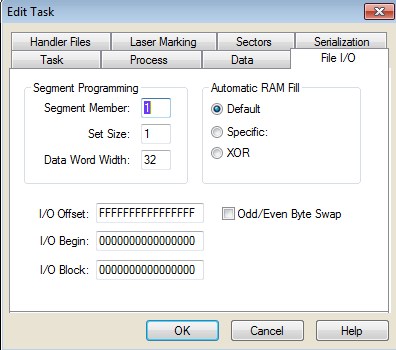
The File I/O tab allows you to configure the special translation options for your data. Some of these options are necessary for instances when your data is to be distributed over multiple devices. Some of the options allow you to specify unused areas of the device. And some of the options are available to allow you to use only a portion of your data file.

¤ The File I/O Tab
Segment programming is useful when programming with a data file which contains data for more than one device.
A segment is a portion of the data file that will be programmed into the device. In this box, enter a number to select which segment will be programmed into the device. The Segment Member value must be no larger than the Set Size value, or no larger than the Data Word Width divided by the Device Word Width.
Enter the number of segments that the data file is divided into. The Set Size is a function of the targeted device and file size. For example, a 4 K file being programmed into four 1K memory devices will require a Set Size of 4.
This parameter sets the number of bits being used in the targeted system. Typically the data word width values are 8, 16, and 32. This parameter must be at least as large as the word width of the selected device and, if it is larger, it must be an integer multiple of the word width of the selected device.
This parameter selects the data (if any) that programmer RAM will be filled with prior to initiation of an I/O transfer to the programmer.
Default: Unused locations are initialized to the unprogrammed state for the device.
Specific: Unused locations are filled with the specified two-digit hex number.
XOR: Unused locations are sequentially filled with two-digit hex numbers.
The address where data is placed in programmer RAM is calculated by taking the incoming address, subtracting the I/O Offset, and adding the I/O Begin address.
Note: The special value FFFFFFFFFFFFFFFF causes the I/O offset to default to the first incoming address. In this case, the first incoming address is subtracted from each incoming address (and the I/O Begin address is added) to calculate the address where data is to be placed.
The I/O Begin parameter sets the first programmer RAM address to which data is to be stored in a data transfer operation. The default value of I/O Begin is 0000000000000000.
The I/O Block parameter sets the number of bytes to be used in data transfer operations.
The default value of 0000000000000000 causes the I/O block size to be set to the size of the selected device.
Check this box to enable Odd/Even Byte Swap, which transposes odd and even order bytes within the data file. More.
• • •